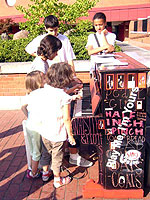English
|
---Event Information---
■Title:Play Me, I'm Yours:London 2009/ The Street Pianos Project ■Artist:Luke Jerram ■Period:Mid June to mid July, 2009 ■Venue:30 spots in London ■Co-hosts:City of London Festival/Sing London |

photo by Luke Jerram

Soho Square
One sunny day, I went to the centre of London, looking for the street pianos. My first stop was Soho Square. It is a park located in the heart of London, surrounded by many shops, cafes, restaurants and theatres, and offers Londoners an urban oasis. Where is the piano? I stepped into the square wondering. Then, I heard sounds coming from behind some trees.
What I saw was a brown, upright piano, painted with pictures and the words 'Play Me, I'm Yours!' in red and pink. A man in a colourful shirt was playing jazz on it. People were enjoying the music on the wind in their own style. Someone were listening to the music right beside the piano, others were enjoying it from a distance, tapping to the rhythm on a bench, or having lunch on the grass.

Start the show!
One of the listeners talked to the musician between the pieces. Presumably having been requested something, he started to play another piece. 'Do you want to play, too?' said the musician, then another man began to sing and play a number by the Beatles. Those who were walking on the street turned into the square and joined in the song. In the meantime, a group of musicians dressed like street entertainers came forward and started a show with the piano, encouraging people to sing together. While sitting on the bench for just 30 minutes, we could enjoy the various kinds of music and people around the piano.

Artist: Luke Jerram
The key person behind the project 'Play Me, I'm Yours!' is a British artist, Luke Jerram. It is, in fact, an artwork of Luke, who is active in various fields of art. When he places a piano on the public street, it is no one's property any more. It is rather 'Yours' - for the people who pass by on the street every day. Then, what happens to it? A passer-by plays the piano, and another passer-by stops and listens to it. They start a conversation and create a community around the piano. Expressed as 'a blank canvas' by Luke, how they use the piano and what they create with it are up to them.

Luke playing the piano
'Living in an urban city, even if we see the same people at the bus stop every morning, we don't usually talk to each other. Why don't we know anything about our neighbours?' This project was born out of such a question in everyday life. ''Play Me, I'm Yours' is designed to provoke people, who occupy the same space, into talking to one another and engaging in their community,' said Luke.
 Sao Paolo/ photo by Luke Jerram  Let's SIng London! |
The street pianos project was launched with 15 pianos in Birmingham in March 2008, and is now touring internationally: October 2008 to Sao Paulo in Brazil, January 2009 to Sydney in Australia. At the Sydney Festival, over 200,000 people played or listened to the street pianos. This time, in London, it was realized in collaboration with 'City of London Festival', a summer arts festival with a history of over 40, and 'Sing London', a series of events aiming at connecting people in London through singing. Therefore, the pianos were also used for those events. I saw a man playing the piano on Carnaby Street, being asked by a group of strangers, 'We saw information about Sing London that we can sing here! Could you play 'Hey Jude' for us? Let's sing, everyone!' and he kindly played it from memory. (watch Hey Jude video by a greater group)

Plaza Shopping Centre
Each piano were decorated in various colours and designs. Half of them were decorated by Luke, but the rest by local artists. The one on the lively Carnaby Street was painted with colourful fish and the sea: the one by the Millennium Bridge over the Thames with yachts, the one in front of the British Library with lots of words, the grand piano in the Plaza Shopping Centre with the Union Jack, the one in Soho Square near a hospital with hearts, and the one in a market with many photos of local people enjoying the piano.

Carnaby Street
Where did these pianos come from? It must cost a lot to install as many as 30 pianos. 'These pianos were donated by a piano transport company. Instead of destroying the abandoned pianos, we brought them to the streets and decorated them. Therefore, the pianos were free. The actual costs were for the tuning and moving them, which were funded by the City of London Festival this time,' Luke explained. Once decorated, the abandoned pianos will be reborn as a symbol of the city, with a small budget. As a matter of fact, the condition of the pianos was so poor that tuning could not help: some keys or pedals were not functioning. Nevertheless, people enjoyed playing them, as if it did not matter at all. Moreover, they turned it into an ice-breaker for conversation, 'You see? This key doesn't come back once struck!'

Millennium Bridge
People could play anything they liked, such as classical, popular or jazz, and, for those who didn't know what to play, a song book was attached to each piano. It contained songs about London and some selected songs, such as songs about trains for the piano at a train station, or songs about water for the one by a bridge. Another unique feature of this project was the interactivity of its official website. People could post their event information by writing down the time and venue on the website, and posting their photos, videos and comments of their experiences with each piano. It was free to use as a place for school-children to perform music outside, or for professional or amateur pianists to promote their concerts or CDs. There was a duo who made an ambitious attempt at a piano marathon, to play 24 pianos in 8 hours!

British Museum
When I walked around London looking for the street pianos, most of them were being played even if there was no planned event, on either weekdays or at weekends. As soon as one person finished playing, someone else approached and played in turn, although they were not waiting in line. Once, I found a piano that was not being played at the square in front of the British Library. As I played some notes, a family noticed it and approached me. 'Would you like to play?' I offered the seat to the children. Then, the older sister began to play a number from a film soundtrack. When she finished playing and left the piano, the younger sister, who did not seem to have played it before, slipped into the seat and said, 'I want to play, too!'

St Paul's Cathedral
I asked Luke, 'Why did you choose a piano rather than other instrument?' He replied, 'Pianos are easy to play for everyone, because people can easily find the tune and make sounds on the keyboard, unlike violins. So even if a piano appears all of a sudden in front of you, you can make some music with it. Also, with a piano, you can play solo, ensemble with other instruments or singers. Everyone can play it and share the music with other people, so it is quite suitable for connecting the people in the community'. It is planned to donate these pianos to local facilities, and so contribute to the community.

Liverpool Street Station
Touring around the world, did the street pianos receive different reactions? Luke described them as follows. 'When we went to Sao Paolo, most of the people saw a real piano close-up for the first time, so many people came from miles away and really enjoyed playing the piano. On the other hand, there are plenty of hidden pianists in London, so we can really enjoy the talent and creativity they exercise in various ways.' 'Are you planning to come to Japan?' I asked. He answered, 'Of course, I would love to go to Japan. I hope Japanese people will enjoy playing the street pianos as well!'
Report by Chigusa Futako








